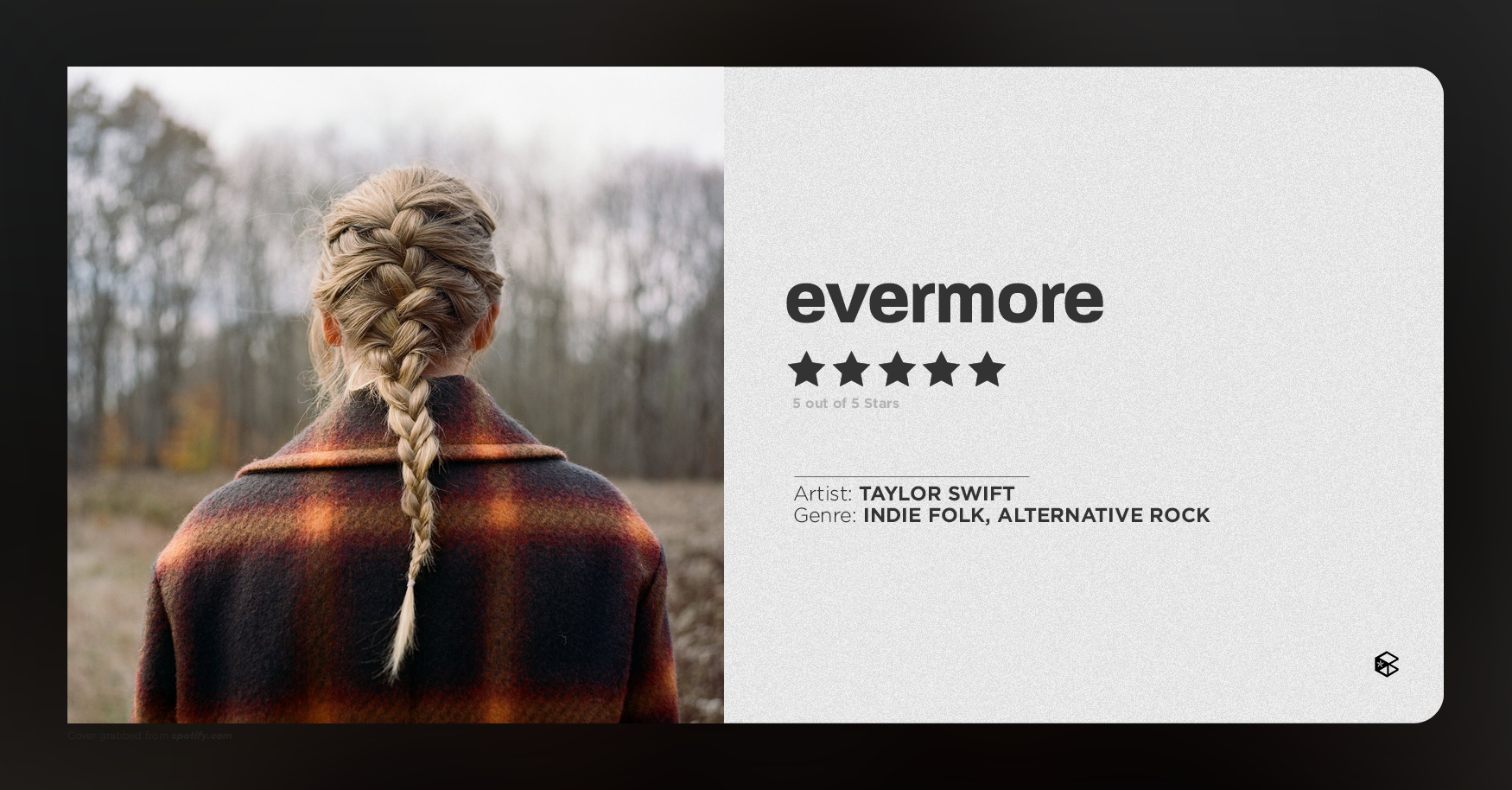In a span of 16 months, Grammy-winning singer-songwriter Taylor Swift released three full-length albums–Lover, folklore, and now, “evermore.” Two days before she turned 31, she took to Twitter to surprise the world with evermore, the sister album of “folklore.”
With folklore’s tidal success, having six nominations for the 2021 Grammys, Best Pop Vocal Album and Album of the year included, Taylor Swift produced the album, alongside Jack Antonoff, Aaron Dessner, and Bon Iver’s Justin Vernon. With more freedom and a little bit of experimentation, they have delivered to the world “evermore.”
According to Swift’s Twitter post, “to put it plainly, we just couldn’t stop writing songs.” The team also welcomed into the musical kitchen some longtime friends and former tour buddies, like pop-rock band HAIM and William Bowery, pseudonym of Joe Alwyn, who’s Swift’s boyfriend. He co-wrote three tracks ("champagne problems," "coney island" (ft. The National), and title track "evermore," ft. Bon Iver) in the album and played the piano for some.
The ninth studio album evermore consists of 15 songs with two bonus tracks for the deluxe edition, “right where you left me” and “it’s time to go.”
Etherealism with evermore
Premiered on Dec. 11, evermore’s lead single “willow” was Swift’s self-directed music video. As it is currently trending no. 1 on YouTube as of writing, the song radiates a Disney fairytale-like story narrative while casting spells for love “as if you were a mythical thing.”
Continuing with the minimal, cottagecore palette, “evermore” is the perfect winter companion, with the lingering sound of the homey piano and almost serene guitar patterns. Its cozy and dreamy sounds bring you to a cabin in the woods; Swift’s promotional photos captured her in plaid, flannel, and French braid, walking around a barren field.
Tales untold, a magical journey unfolds
Being known to write about her own experiences, especially on heartbreaks, Swift rediscovered a fresh side of her musical career by dropping her first indie-folk album “folklore” which featured stories of other people. Swift has set aside autobiographical pieces on her last two albums and sung about other people’s tales.
Just like the infamous love triangle of Betty (“cardigan”), James (“betty”), and “august” girl, Rebekah Harkness (“the last great american dynasty”), and even Swift’s grandfather (“epiphany”), in “folklore,” her storytelling of people’s tales continue as pure-poetic lyricism is found in evermore as more stories unfold and told through Swift’s eyes.
“‘Tis The Damn Season” introduced Dorothea, the small-town girl who flies to Hollywood to chase her dreams, comes back to her old place for the holidays, and rekindles an old flame with her past lover. On the other hand, “dorothea” shows his side of the story, singing “a tiny screen’s the only place I see you now,” wondering if she’s still the same soul he met under the bleachers.
“I’m the fourth Haim sister now. Confirmed.” Swift says, talking about her collaboration with her long-time friends, the Haim sisters, with “no body, no crime.” She continues by saying she thinks Este (one of the sisters), “would be stoked to be in a song like that.” The murder mystery story narrates the story of Este, her cheating husband–who eventually murdered her, and how her friend and sisters avenged her death by also murdering her husband. folklore’s “Mad Woman” also reflects the story of a woman full of rage. The song starts off sounding like Swift’s country music roots, resounding with sirens, guitars, and tunes of harmonica.
On folklore, Swift sang about her grandfather, Dean, with its 13th track “Epiphany.” Moving forward to evermore, she took inspiration from her grandmother, Marjorie Finlay, also with the 13th track, “Marjorie.” Being an opera singer herself, Finlay inspired Swift to most of her musical pursuits. Even using her own vocals as back-up for the track, Swift eulogized her, singing “what died didn’t stay dead.”
Supplementary Recommendations
- “gold rush” is such an ode for a daydreamer. Giving off a reminiscent vibe of “lover,” this song encapsulates a hint of the singer’s ex as “I don't like that falling feels like flying ‘til the bone crush.”
- “‘tis the damn season” is a track that embarks on a fleeting yet intimate relationship with someone. Let the lyrics speak volumes: “Now, I'm missing your smile, hear me out. We could just ride around. And the road not taken looks real good now,” as Dorothea comes back home for the holidays.
- “evermore” (ft. Bon Iver) is a meditative, titular track itself. A heavenly masterpiece with imagery that sums up a redemptive ending. Period.
- “happiness” is the last song written for the said album. This calm yet destructive context of leaving a relationship gives a melodious bliss, “Past the blood and bruise, past the curses and cries. Beyond the terror in the nightfall, haunted by the look in my eyes.”
- Written with William Bowery, “champagne problems” shares a story of a woman turning down a marriage proposal. Despite the melancholy, Swift’s euphonious voice satisfies the piano harmonies.
“Not a lot going on at the moment…” as Taylor Swift says on her social media accounts, then proceeds to drop two full-length albums and a film, while simultaneously working on re-recording her masters. After more than a decade in the spotlight, Swift, yet again, exceeded expectations. Her versatility in music continues to awe critics and fans alike, accompanied by her soft voice, she seems to save 2020 through her music.
Here we say, again, thank you, queen.
Stream evermore here.


